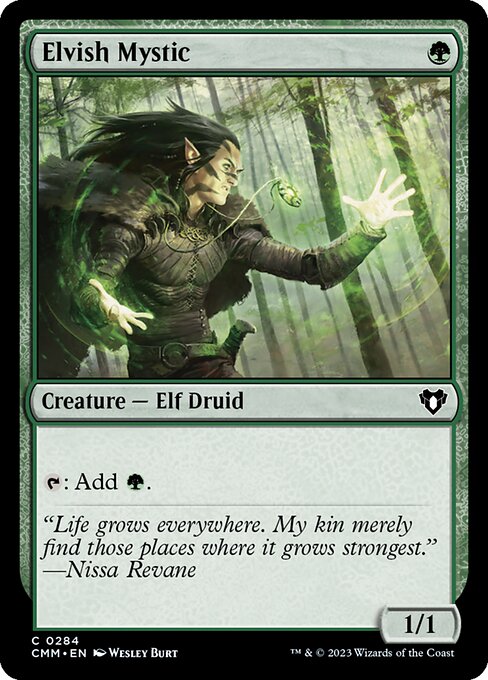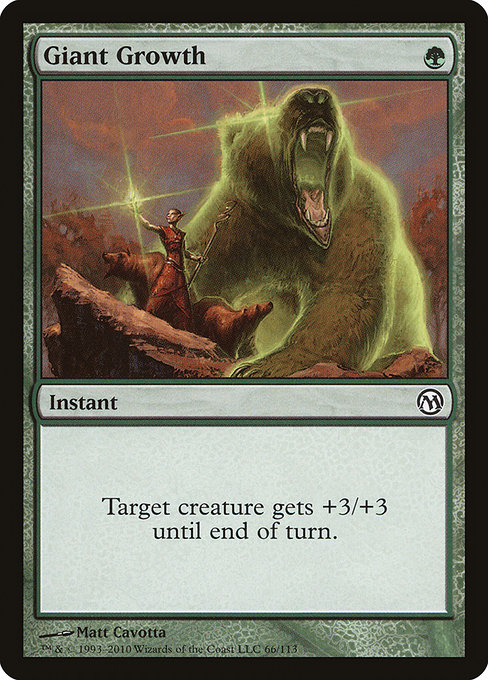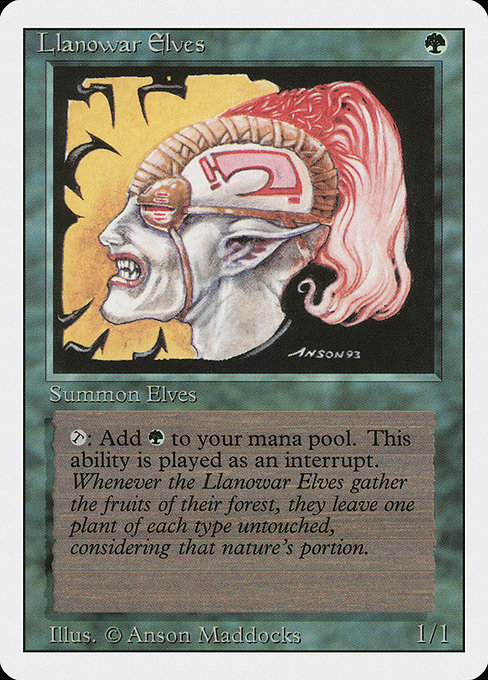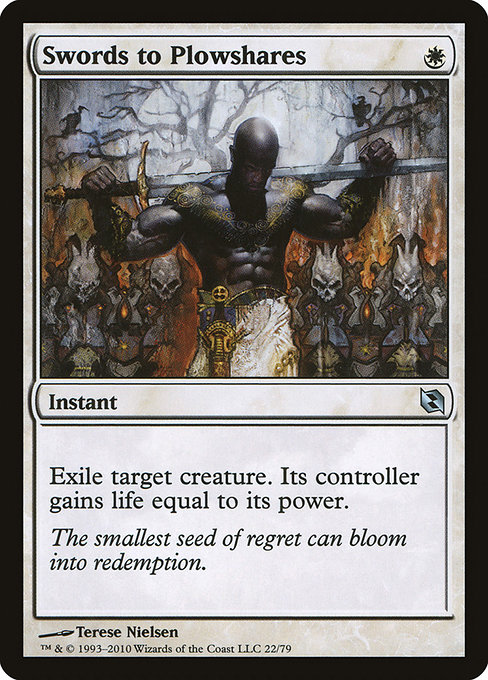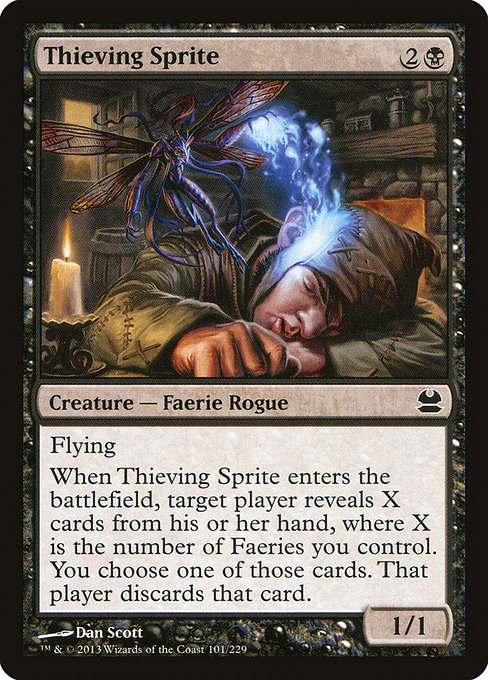
Thieving Sprite

Guide Sections
Strategy Guide
Last updated 2025-07-06Quick Summary
Thieving Sprite is a 1/1 black Faerie Rogue creature with flying. Its most significant ability triggers when it enters the battlefield. This ability targets a player and forces them to reveal X cards from their hand, where X is equal to the number of Faeries you control. You then select one of those revealed cards, and the targeted player discards that card. Note that the number of Faeries you control is determined at the moment Thieving Sprite enters the battlefield; any changes to your Faerie count after the ability resolves will not affect the number of cards revealed.
If you control no Faeries besides Thieving Sprite when it enters the battlefield, X will be 1, and the targeted player will reveal only one card. This means that even a single Thieving Sprite can be a disruptive element. Conversely, if you have a board full of Faeries, such as Ephemerate copies, or other Faerie synergies like Faerie Conclave, you can force your opponent to reveal a significant portion of their hand, allowing you to choose the card that most disrupts their strategy. This makes the Sprite’s effectiveness heavily reliant on the number of other Faeries present in your deck and strategy.
There is an important edge case concerning the target player's hand size. If the target player has fewer than X cards in their hand, they reveal their entire hand. You then choose one card for them to discard. If they have no cards in their hand, the ability will still trigger, but the player will reveal nothing and won't discard any cards. The ability has no effect in this instance, but it still uses the targeted player's action, thus avoiding a 'miss' and potentially giving information.
Thieving Sprite's strategic application centers around disrupting opponents' hands, particularly those relying on specific cards for their game plan. Its effectiveness is directly tied to the number of Faeries you control, making it a key component in Faerie-tribal strategies. Decks focused on Faerie synergies, often employing a tempo-oriented approach, benefit most from its inclusion.
The card excels at disrupting combo decks, forcing them to discard key components of their strategy. Imagine a Splinter Twin deck; discarding a crucial creature or instant can significantly delay or even derail their game plan. Similarly, it can hinder control decks by removing answers to your threats, or crucial card draw. Against aggro decks, the utility is lower; however, discarding a key removal spell or a crucial pump spell is certainly not insignificant.
Thieving Sprite primarily fills the role of a disruptive element and a tempo play. Its low mana cost allows it to be played early, applying pressure while simultaneously disrupting the opponent's strategy. Furthermore, its flying ability provides evasion, allowing it to connect for damage and increase the pressure even more. The number of Faeries on the battlefield directly increases the Sprite's effectiveness, incentivizing players to include multiple Faeries in their deck to maximize its impact. Cards like Faerie Harbinger can help ensure you have enough Faeries in play to get significant value.
In short, Thieving Sprite is a powerful tool for Faerie tribal decks looking to disrupt opponents and control the tempo of the game. Its synergy with other Faeries and its ability to disrupt various strategies make it a valuable addition to specific archetypes.
The Thieving Sprite's effectiveness hinges on the number of Faeries you control. Building a Faerie tribal deck is the most straightforward approach to maximizing its impact. A critical mass of Faeries ensures you can force your opponent to reveal and discard a significant number of cards, disrupting their game plan. Ephemerate or Curious Obsession can be used to bounce the Sprite back to your hand for repeated uses, ensuring consistent disruption. Creatures like Faerie Duelist, Mistcaller, and Scion of Oona directly contribute to the Faerie tribal theme, increasing the number of cards your opponent reveals.
Synergies extend beyond simply having many Faeries. Cards that allow you to cheat Faeries onto the battlefield can powerfully increase the impact of Thieving Sprite. For example, Intruder Alarm triggers on each Faerie entering the battlefield. This means casting multiple Faeries will trigger multiple Thieving Sprite abilities, allowing you to discard multiple cards from your opponent's hand. Consider including cards that help you control the board, such as Counterspell or Murder, to create an opening to successfully deploy your Faerie strategy.
While the Sprite itself has a small body, it's more of a tempo card, aiming to disrupt your opponent's hand rather than directly winning the game through combat. Therefore, the deck requires a strategy to close out the game after disrupting your opponent. Cards like Gurmag Angler can be a good fit for a black Faerie strategy, closing the game after a series of disruptive plays by the Sprite. Combining the Sprite with consistent card draw, like Night's Whisper, or hand-disruption spells, such as Thoughtseize or Inquisition of Kozilek, further bolsters its effect by keeping your hand full and your opponent's empty.
Thieving Sprite's viability is highly format-dependent, hinging on the prevalence and effectiveness of Faerie tribal strategies. In Standard, its impact is likely to be minimal. While a 2/B mana cost for a 1/1 flyer is passable, the discard effect requires a critical mass of Faeries to be truly impactful. The current Standard metagame doesn't heavily feature Faerie synergies, making it difficult to consistently achieve the necessary number of Faeries to make this card a worthwhile inclusion. Its low power and toughness also make it exceptionally vulnerable to removal spells like Fatal Push and Go Blank.
Historic offers slightly more potential. While not a dominant archetype, Faerie tribal decks do exist in Historic. Here, Thieving Sprite could find a niche in a dedicated Faerie shell, acting as a supplementary discard outlet alongside cards like Ephemerate and Curious Obsession. However, competition from stronger discard options and the overall prevalence of efficient removal would still limit its effectiveness.
Commander presents the most promising environment for Thieving Sprite. In a constructed format where decks can be highly customized and tailored toward specific tribal strategies, a dedicated Faerie tribal deck could leverage Thieving Sprite's discard effect more effectively. Within such a build, Thieving Sprite could synergize well with other card draw effects and provide a disruptive element against opponents' strategies. The larger game state and potential for multiple Faeries makes a higher value X more realistic. However, even here, its low stats still make it vulnerable to board wipes and targeted removal. Consider pairings with protection spells like Unsummon or Hexproof enchantments.
Thieving Sprite shines in decks built around swarming the board with Faeries. Imagine a scenario where you already control three Faeries – Whisperwind Changeling, Faerie Duelist, and Scion of Oona. Playing Thieving Sprite forces your opponent to reveal four cards from their hand. If they're holding a crucial removal spell like Doom Blade targeting one of your Faeries, or a powerful threat like Goblin Rabblemaster, you can force them to discard it, disrupting their strategy and securing your board state.
Another impactful scenario arises when your opponent is holding back crucial answers. Suppose they have a hand full of answers but are hesitant to play them due to your board presence. A single Faerie Miscreant along with Thieving Sprite forces them to reveal two cards, allowing you to potentially snag a counterspell that could have stopped your next game-winning play, such as Crystal Shard. This proactive disruption can win you the game.
Finally, even with just one or two Faeries on the board, Thieving Sprite provides valuable information. Revealing even one or two cards from your opponent's hand can give you valuable insight into their strategy and allow you to adjust your own game plan accordingly. For example, seeing a Lightning Bolt in their hand can inform you of the potential risks in attacking with your creatures. This tactical advantage is valuable regardless of whether you successfully discard a card.
Thieving Sprite, a common black Faerie Rogue from Masters 25 (mma), has a deceptively simple yet impactful design. Its ability to force a card discard, scaled to the number of Faeries on the battlefield, quickly made it a staple in various formats focusing on Faerie tribal strategies. Prior to its appearance in Masters 25, black didn't have a readily available, efficient way to directly disrupt an opponent's hand in the early game outside of cards like Thoughtseize which were significantly more costly. Thieving Sprite provided a much cheaper, albeit less powerful, alternative, particularly within aggressive Faerie strategies.
The card's impact varied based on the metagame. In constructed formats where Faerie tribal decks were competitive, Thieving Sprite often proved its worth, forcing opponents to discard key spells or creatures, thereby disrupting their game plan. The ability to scale its discard effect based on the number of Faeries present synergized well with other cards like Whispering Specter and Scion of Oona, creating a compounding effect that severely hampered opponents. Its low mana cost and flying made it a reasonably evasive threat in its own right. While not a game-changer on its own, it served as a valuable piece in a synergistic tribal strategy.
Reprints of Thieving Sprite have been relatively infrequent, highlighting its initial success as a common card in Masters 25. The lack of further reprints indicates that Wizards of the Coast generally viewed it as a well-balanced and appropriately-powered card for its rarity, neither requiring errata nor demanding a reprint in more widely accessible sets. Its absence from recent sets, however, doesn't diminish its role in shaping the gameplay of Faerie tribal decks during its prominence.
Thieving Sprite's flavor text perfectly captures the mischievous nature of Faeries. The art likely depicts a tiny, winged creature with a sly expression, perhaps mid-flight and clutching a stolen item—though without seeing the actual art, this is just an educated guess based on the card's name and abilities. The design fits thematically within a set featuring Faeries (presumed to be MMA, though the set isn't explicitly named in its entirety). The "reveal X cards, discard one" effect emphasizes the Faerie's sneakiness and ability to pilfer information as well as objects. This mechanic interacts well with other Faerie tribal cards, creating synergistic gameplay. Imagine playing multiple Faeries alongside Thieving Sprite, leading to a significant hand disruption effect. The low mana cost and relatively low power/toughness balance this disruptive ability. If the set leans towards aggressive strategies, Thieving Sprite could act as a disruptive element, slowing opponents down while the player pushes for damage with other creatures. If the set focuses on control or midrange strategies, the Sprite offers valuable tempo control without being overly oppressive.
The Thieving Sprite, costing {2}{B}, falls into a budget-friendly range for Magic: The Gathering. Its common rarity further supports this. Many players build successful decks without relying on expensive rare or mythic rare cards. The mana cost is relatively low, and the card's effect, while impactful, doesn't rely on exceptionally expensive support cards to be effective.
Cheaper alternatives will depend on the desired effect. If the goal is disruption, cards like Thoughtseize (though significantly more expensive) offer a more direct approach, though at a higher mana cost. For budget-friendly card disruption targeting the opponent's hand, options like Duress or Inquisition of Kozilek offer similar effects at varying mana costs. If you’re looking for other cheap flying creatures, there are many alternatives depending on your color identity. Skyblinder Couriers is a great example of a low-cost flying creature, though it does not have hand disruption capabilities. The best alternative will depend heavily on your deck's strategy and overall budget.
The seemingly simple Thieving Sprite offers surprising strategic depth beyond its straightforward card-theft mechanic. Its power hinges on maximizing the number of Faeries you control, turning it from a single-card removal spell into a potentially devastating engine. Consider pairing it with cards that generate Faeries in large numbers, such as Ephemerate to repeatedly bounce and reuse it, or Kindred Discovery to flood the board with tokens. This synergy allows for multiple thefts per turn, rapidly dismantling an opponent's hand.
Beyond sheer volume, consider the timing of deploying Thieving Sprite. Using it after your opponent has played key spells, but before they've had a chance to draw replacements, can severely disrupt their game plan. Conversely, holding it back until you know they're holding crucial answers, like Counterspell or Wrath of God, can be equally potent. The choice of which card to steal is also crucial; discarding a land in the early game might seem insignificant, but later, stealing a powerful spell or a key creature can be game-winning.
A less obvious strategy involves using Thieving Sprite to manipulate your opponent's hand for tactical advantage, rather than outright disrupting them. For example, forcing them to discard a land when they're low on mana can severely hamper their ability to play powerful spells. Or, if you suspect they're holding removal for a critical creature, stealing a weaker card can force them to keep the removal in hand, allowing your threat to survive another turn. The information gained from seeing their hand is just as valuable as the card stolen. In short, mastering Thieving Sprite is about understanding both your own deck and your opponent's, maximizing both its destructive and tactical potential.
Common Mistakes with Thieving Sprite
A frequent mistake is misjudging the optimal time to play Thieving Sprite. Playing it too early, before you have established a significant Faerie presence, severely limits its effectiveness. With only one or two Faeries on the board, the opponent might only reveal a few cards, many of which may be unimportant lands or low-impact spells. Waiting until you have a larger board state with multiple Faeries allows you to force your opponent to reveal a more substantial portion of their hand, maximizing the chance of discarding a key threat like Lightning Bolt, a crucial removal spell, or a game-winning card.
Another error is failing to consider the opponent's hand composition. While discarding a land might seem inconsequential, it can be devastating if they are mana-screwed. Conversely, targeting a key spell or creature is far more impactful. An experienced player will assess their opponent’s potential plays, game state, and mana to choose the most disruptive card to discard. Overlooking this crucial aspect of strategic card selection can diminish Thieving Sprite's value.
A final, often overlooked mistake lies in neglecting synergy with other cards. Thieving Sprite benefits greatly from a synergistic Faerie deck. Cards that enable you to quickly deploy multiple Faeries, such as Faerie Conclave or Ephemerate, significantly enhance the impact of its ability. Underutilizing such synergistic elements limits the overall power of Thieving Sprite and your Faerie strategy as a whole.
The Thieving Sprite is a cheap, evasive creature that offers disruption. Its power lies in its enters-the-battlefield effect, allowing you to force a card out of an opponent's hand. The number of cards revealed scales with the number of Faeries you control, making it stronger in Faerie-heavy strategies. While a 1/1 body is fragile, its Flying ability makes it difficult to block, increasing its chances of surviving long enough to trigger its effect. This card shines in aggressive Faerie strategies alongside other cards like [Whispering Fiend] to apply early pressure and disrupt your opponent's game plan. However, its effectiveness is heavily reliant on already having other Faeries on the battlefield; otherwise, its impact is severely limited. Therefore, Thieving Sprite is best played in decks that can consistently deploy multiple Faeries early in the game.
